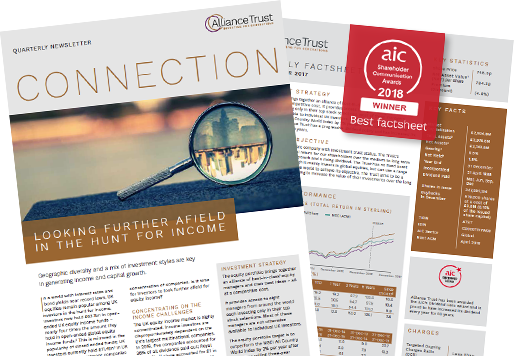Professional Investors and Alliance Trust
Given the breadth of strategies that Alliance Trust offers shareholders, how do professional investors fit the proposition into a wider portfolio? We spoke to three who are using the trust to good effect in rather different ways.
NICK WOOD, QUILTER CHEVIOT INVESTMENT MANAGEMENT
Given their long histories, it is unsurprising that Quilter Cheviot has had exposure to Alliance Trust to one degree or another for decades. “Our views on the trust have changed over time, but improved significantly following the change in management in 2016,” said Nick Wood, Quilter Cheviot’s Head of Investment Fund Research.
He recognises that for many wealth managers, Alliance Trust poses a “slightly awkward” question: why would one want to invest in a vehicle that selects a number of best-in-breed portfolio managers – a key part of a wealth manager’s own job? For Wood, the answer lies in Alliance Trust representing “something of a one-stop shop for global equity exposure”.
“With the trust having a mix of styles within the underlying managers, I’d expect it never to be so in or out of favour purely due to the ebb and flow of different investment styles,” he said.
“Whilst our research team trawls the globe for new ideas, the differentiator with Alliance Trust, is that its managers in all but one instance hold concentrated 20-stock portfolios that would not be viable in a regular fund, given the rules on concentration. In other words, we can’t specifically replicate the portfolio ourselves.”
For example, River and Mercantile’s Hugh Sergeant manages a very well-diversified global equity, Undertaking Collective Investment in Transferable Security (UCITS) fund, but limits himself to 20 best ideas for Alliance Trust, while Toronto-based Black Creek Investment Management, another global equity manager held within the trust, is not currently available to UK investors via a UCITS fund.
So how does Quilter Cheviot use Alliance Trust? It might sit alongside one or two other managers in smaller portfolios to provide non-UK equity exposure, representing up to 5% of total holdings. It might also be used in junior Individual Savings Accounts, again often alongside a couple of other investments, as a way of obtaining broad exposure to equity markets without having to invest in multiple funds.
RODDY KOHN, KOHN COUGAR
Established in 1987, Kohn Cougar was at the forefront of using investment trusts, including Alliance Trust within three years of its inception.
“In those days investment trusts were not widely recommended, despite the clear attractions of their features,” said Roddy Kohn, Managing Director of the Bristol-based firm. “We like that the structure brings a number of benefits to investors – low charges, skilful fund managers and access to people and places outside the mainstream.”
Since then, Alliance Trust has undergone significant structural change. “The opportunity for investors to have one fund with eight fund management groups managing the underlying investments, bodes well for investors who want a broad church of managers and styles,” said Kohn.
“For example, the selection of one set of managers focused on a growth portfolio whilst another focuses on value, allows investors to benefit from a barbell approach.
“The latest line-up of most attractive managers in their class means investors can feel confident that competition amongst them is keen”. Kohn regards the trust as well suited to investors looking for both long-term growth and a modest level of income from a broadly diversified portfolio of equities.
“Investors who can accommodate such trusts tend to be higher-rate taxpayers and relatively sophisticated investors, but we wouldn’t hesitate to use this fund for children as a way of funding university or first home costs, provided the investment horizon on offer is a sensible one.”
The wealth manager likes to buy investment trusts when they are cheap, and points to Alliance Trust trading on a meaningful discount to the value of its underlying assets (6.7% at the time of going to press).
Clients have received an extra performance kicker from other investment trusts moving to a premium in the past. “Today looks like an attractive time to invest in Alliance Trust, given the potential for its discount to narrow,” added Kohn.
JAMES SULLIVAN, CORAM FUNDS
Coram Funds is a relative newcomer to the share register of Alliance Trust. James Sullivan, manager of the multi-asset range, bought a position in the trust in the autumn of 2018, as a means of owning global equities while betting against the US stock market. At the end of October, Alliance Trust had 47.2% of its assets in North American equities, almost 11% less than the MSCI All Country World index. To achieve his aim of owning the world, minus the US, he hedged the US exposure by shorting the S&P 500 index.
“Our process identified that the US market had become stretched and overshot what we interpreted to be fair value, whereas many indices on a global basis remained in line with their longer-term averages,” said Sullivan, Managing Director of the UK business of MitonOptimal, which bought Coram Asset Management in 2016.
“As a result, our net equity position was unmoved, but the average multiple of our portfolio was reduced, therefore improving the fundamentals of our portfolio range.
“We accept that Alliance Trust has US exposure as part of its mandate, but also recognise there is ‘active’ stock selection within, so not blindly paying exacerbated index multiples.
“Taking that on board, and being focused with our hedging policy, we can eliminate much of the ‘beta’ of the US market, thus leaving our fund exposed to the rest of the world.”
It is rare for Sullivan to buy a global fund, tending to prefer to access geographical regions with more precision, but he considers Alliance Trust to be the “right vehicle” for this particular trade.
“Offering copious liquidity in the shares paired with a discount of circa 7%, it was the most effective way to hedge against our short S&P above and beyond a cheap passive alternative,” he said.
“Our portfolio is materially overweight in the UK and Asia, and once our hedging strategy is factored in, Alliance Trust complemented that stance rather than neutralised it.”






